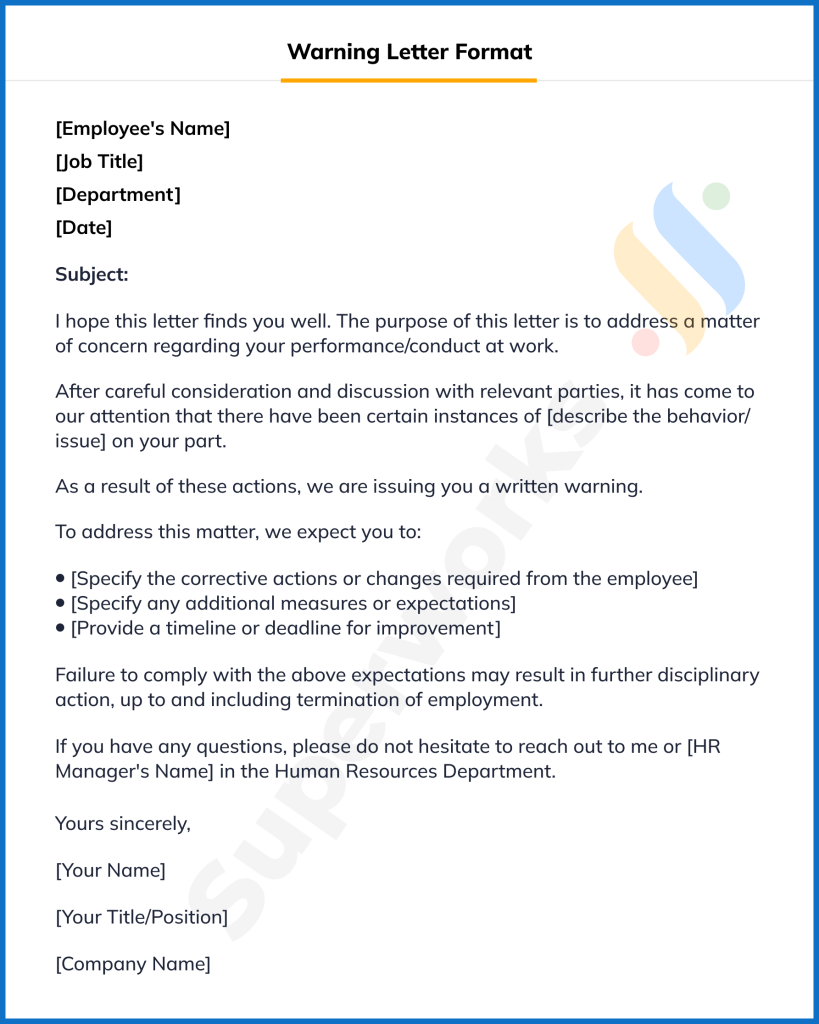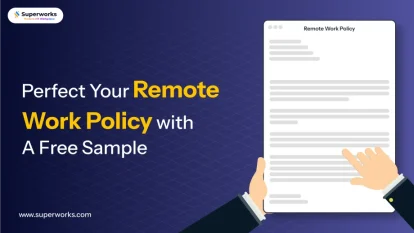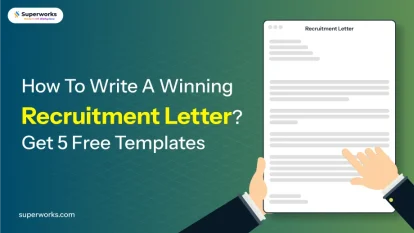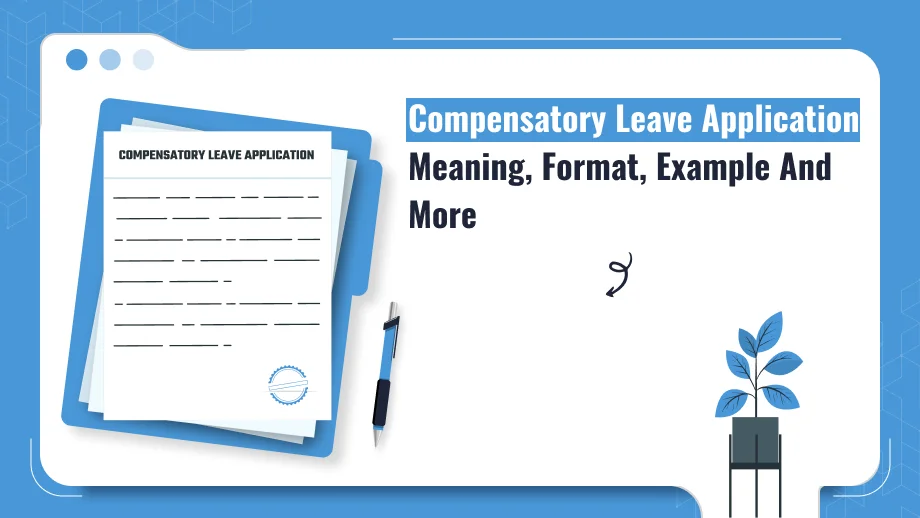Grab a chance to avail 6 Months of Performance Module for FREE
Book a free demo session & learn more about it!
-
Will customized solution for your needs
-
Empowering users with user-friendly features
-
Driving success across diverse industries, everywhere.
Grab a chance to avail 6 Months of Performance Module for FREE
Book a free demo session & learn more about it!
Superworks
Modern HR Workplace
Your Partner in the entire Employee Life Cycle
From recruitment to retirement manage every stage of employee lifecycle with ease.


Seamless onboarding & offboarding
Automated compliance & payroll
Track performance & engagement
Get Your Hands On Simple Warning Letter Format: 6 Best Samples
- warning letter to employees
- 14 min read
- June 7, 2023
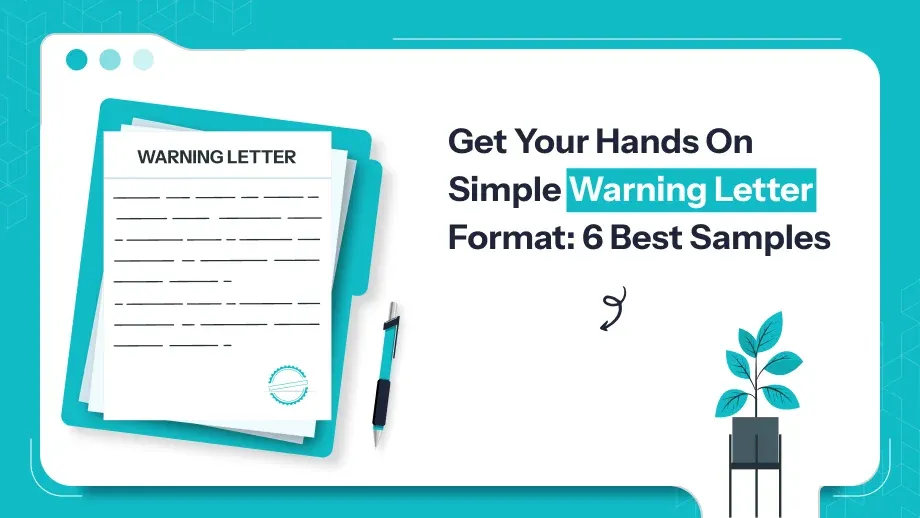
Do you know that, “Warning letter format in Word” is one of the most searched terms by HR professionals? But why in the world do HRs have to search it so frequently? And why warning letter templates are so hot in Google searches? So, let’s understand the phenomena…
A warning letter format for employee holds a very crucial status in official documents in numerous professional settings! Especially for providing a means for employers, supervisors, or authorities to communicate concerns, address misconduct, or highlight areas of improvement.
However, amidst the vast amount of information available, there are several myths & misconceptions surrounding an employee warning letter that need to be corrected! Henceforth, through the medium of this blog, we aim to debunk 5 common myths associated with a warning letter format, and moving forth we will also be providing 6 most searched samples here!
Once you clarify these misunderstandings, professionals can gain a deeper understanding of the proper structure, tone, and content required for effective warning letters.
But, before we discuss the myths & go through those 6 most searched samples- let’s start with the basics!
- Best Warning Letter Format
- What Is A Warning Letter?
- What is the Purpose of A Warning Letter?
- Why is A Well-Written Warning Letter Format Important?
- Debunking 5 Myths of Warning Letter Format
- #1 Myth: There is only one universal warning letter format.
- #2 Myth: Warning letters must always be in a formal tone.
- #3 Myth: Warning letters should be lengthy and detailed.
- #4 Myth: Warning letters should focus solely on negative feedback.
- #5 Myth: Warning letters should be delivered immediately after an incident.
- What to Include in a Warning Letter Format?
- The Right Warning Letter Format
- The Right Warning Letter Format
- Parting Thoughts
Best Warning Letter Format
What exactly is considered the best warning letter to employee format in Word, does any HR professional can tell? Let’s have a look at it, and start to understand it through the definition!
What Is A Warning Letter?
A sample warning letter is a formal communication sent to an individual or organization to address concerns regarding their behavior, actions, or performance. It is a written notification that highlights unacceptable conduct or shortcomings without explicitly mentioning the purpose or intended consequences.
A Warning Letter to Employee
Note:You can download directly from here and edit as per your need.
What Is A Warning Letter?
A warning letter is a formal communication sent to an individual or organization to address concerns regarding their behavior, actions, or performance. It is a written notification that highlights unacceptable conduct or shortcomings without explicitly mentioning the purpose or intended consequences.
The letter aims to inform the recipient about the observed issues and serves as an official record of the concerns raised. By providing this written warning, the sender emphasizes the need for improvement or rectification. A warning letter typically includes details about the problematic behavior or performance, relevant dates, and a request for the recipient to take appropriate actions to address the concerns.
Now that you know the warning letter meaning, let’s know its purposes.
What is the Purpose of A Warning Letter?
A warning letter serves several important purposes, including:
-
Communication:
A warning letter example is here to provide a clear & formal means of communicating concerns or issues to the employee. Furthermore, it keeps ensuring that the message is delivered in writing, and leaves no room for misinterpretation or ambiguity.
-
Documentation:
Once you have issued a warning letter, you can easily create an official record of the problem or concern. This formal documentation is highly crucial for future reference, especially if you just need to take further disciplinary actions. Simply put, the employees can also read this letter as an Employee Self Service.
-
Awareness:
The warning letter to an employee exists to inform the recipient of the specific issues that have been observed. Furthermore, it highlights all kinds of problematic behavior or performance, so there can be a surety that the individual understands the raised concerns.
-
Clarification of Expectations:
A warning letter displaying the termination of your employment will often outline the expected standards of behavior or performance! And this way, you can easily provide clarity on what needs to be improved or rectified.
-
Justification:
In situations where disciplinary actions may be necessary, a warning letter can serve as evidence that the recipient was made aware of the issue and given an opportunity to address it before further consequences are imposed. HR can do fast analysis with HR Analytics Tool.
Searching for ready-to-use templates? Get them on a tap!
Presenting Superworks HR toolkit- an ultimate destination to 100s of easily-customizable templates and samples. With HR toolkit, you will no longer find it difficult crafting important HR letters and emails.
Why is A Well-Written Warning Letter Format Important?
A well-written warning letter format can offer several benefits in various situations. Here are five key advantages:
-
Clarity:
A well-structured warning letter format in the workplace will always be there to ensure that the message is conveyed clearly & consistently. An employee warning letter helps to organize information in a logical manner, making it easier for the recipient to understand the very basic issues being addressed and the required actions they should take to rectify them.
-
Legal Protection:
While writing a warning letter to an employee [a properly formatted one], you should know that it will serve as a legal document! And will continue to protect interests in case of future disputes or conflicts. Furthermore, it will ensure that the letter contains all the necessary details, including the violation or misconduct, consequences, company policies and any relevant regulations involved.
-
Professionalism:
Well-written warnings in a letter demonstrate professionalism & maintain a formal tone throughout the communication. It helps to set a professional standard and ensures that the letter is taken seriously by whoever gonna receive it.
Consistent warning letter templates also reflect the sender’s commitment to addressing issues fairly and systematically, by literally listing a dear employee’s name!
-
Consistency:
A predefined format of the warning letter to employees is always there to ensure consistency in the content & presentation of warning letters within an organization. This consistency is there to help establish fairness & transparency in dealing with all the disciplinary actions & ensures that employees are treated equally in similar situations.
-
Employee Guidance:
A well-structured warning letter format can provide easily provide proper guidance to the recipient. And it outlines expectations, helps in highlighting areas of improvement & suggests corrective actions.
A clear and concise warning letter to employee for poor performance helps employees understand the severity of the issue! And on the same page, it also happens to provide an opportunity for them to rectify their behavior or performance.
Read More – 6 Tips to Write a Professional Late Coming Warning Letter
Debunking 5 Myths of Warning Letter Format
After getting all the crucial information that we will need for our own better understanding, it’s time for a doubt-clearing session! Because there are multiple myths among HR professionals, so let’s start debunking the most common one right away!
#1 Myth: There is only one universal warning letter format.
Reality: To be honest, there is no one-size-fits-all warning letter format but only customization as per requirements. Different organizations in the world may have different guidelines & preferences for the structure & content of warning letters.
Hence, it’s way more than crucial to follow your company’s policies & procedures when drafting a warning letter.
#2 Myth: Warning letters must always be in a formal tone.
Reality: While a warning letter to employee is typically written in a professional & serious tone, it’s completely up to the organization to formally decide the tone! Because to be honest, some companies may prefer a more formal tone, while others may not, maybe they want to keep it more casual and conversational way!
#3 Myth: Warning letters should be lengthy and detailed.
Reality: While warning letters should provide sufficient information about the issue at hand, they do not necessarily have to be lengthy. It’s much more crucial to convey the problem clearly includes,
- Specific behavior or performance concerns,
- Impact on the organization, and
- Necessary corrective actions.
#4 Myth: Warning letters should focus solely on negative feedback.
Reality: While warning letters primarily address areas of concern [as per the management], it’s way more beneficial because to the employee it come with constructive feedback & guidance for improvement. By offering crucial suggestions for how the employee can rectify the issue or boost their performance, you as an HR can foster a more positive & growth-oriented approach.
#5 Myth: Warning letters should be delivered immediately after an incident.
Reality: While it is important to address performance or behavioral issues promptly, rushing to issue a warning letter to employee for unprofessional behavior immediately would not be the best approach. Hence, it is crucial to gather all the necessary information first, and then conduct a fair investigation if required!
And do make sure to provide the employee an opportunity so they can share their side of the story. Such practice will ensure that the warning letter is based on accurate and thorough information, increasing its credibility and effectiveness.
Check out :- Poor performance warning letter
What to Include in a Warning Letter Format?
Here’s a step-by-step guide on how to write a warning letter:
-
Header:
Firstly, you should begin with your company’s letterhead, and should include all the basic information like company name, address & contact information! And don’t forget to mention the date of writing just below the letterhead.
-
Recipient’s Information:
Afterward, please provide the recipient’s name, job title, assigned department & address. If applicable, please mention their employee identification also or any other relevant information.
-
Salutation:
Next step is to include a formal salutation, like “Dear [Recipient’s Name],”
-
Opening Paragraph:
Clearly state the purpose of the letter, like there is a violation of company rules, then please mention them. And also mention that it’s a warning letter stating all specific issues, such as performance, conduct, or any other relevant concern.
-
Body Paragraph(s):
Use this section to provide a detailed explanation of the issue or concern. Include specific incidents, dates, and any relevant facts or evidence. Be objective and avoid making personal attacks. Clearly state the expected behavior or performance standards and explain how the recipient has fallen short of them.
-
Consequences:
Clearly outline the consequences if the recipient fails to address the issue or improve their behavior or performance. This may include disciplinary actions, further warnings, or potential termination of employment. Ensure that the consequences are aligned with the company’s policies and procedures.
-
Support & Assistance:
Offer support or resources to help the recipient improve. This can include mentioning training programs, mentoring, or additional guidance. Reinforce that the company is willing to assist in their development.
-
Next Steps:
Clearly state the expectations moving forward. Specify the timeframe for improvement or resolution and mention any follow-up actions, such as meetings or evaluations.
-
Closing:
End the letter on a professional and supportive note. Encourage the recipient to discuss any concerns or questions with a designated person or their supervisor. Use a closing phrase such as “Sincerely” or “Best regards,” followed by your name, job title, and contact information.
-
Attachments:
If applicable, attach any supporting documents, such as previous warnings, performance evaluations, or incident reports. Clearly reference the attachments in the body of the letter.
-
Proofread:
Review the letter for any errors or inconsistencies. Ensure the tone remains professional, and the message is clear and concise.
The Right Warning Letter Format
Here are six types of warning letters [that people are searching more often]. These are the most commonly user-friendly templates and are designed to address various workplace scenarios effectively without disturbing professionalism and clarity.
1. Warning Letter for Unprofessional Behavior
Purpose:
To address inappropriate conduct or unprofessional behavior that affects workplace harmony.
Template:
[Your Company Letterhead]
[Date]
[Employee Name]
[Employee Job Title]
[Department]
Subject: Warning for Unprofessional Behavior
Dear [Employee Name],
This warning letter that we are sending to you, serves as a formal warning regarding your recent unprofessional behavior.
Incident Details:
[Describe specific behavior with dates, e.g., inappropriate language during a team meeting on [date]]
This behavior violates our company policy [cite relevant policy]. Such actions are unacceptable and disrupt the workplace environment.
Expected Actions:
We expect immediate improvement in your behavior, hence you should adhere to the professional standards that are outlined in our employee handbook is mandatory.
In case of failure to comply, there can be disciplinary actions, which even include the termination of employment.
Sincerely,
[Your Name]
[Your Job Title]
2. Warning Letter for Poor Performance
Purpose:
To notify employees about consistent underperformance or unmet goals.
Template:
[Your Company Letterhead]
[Date]
[Employee Name]
[Employee Job Title]
[Department]
Subject: Warning for Performance Issues
Dear [Employee Name],
This is to address concerns regarding your performance.
Performance Gaps:
[List specific tasks or KPIs not achieved, e.g., failure to meet sales targets for Q3]
Action Plan:
To improve, you are required to:
[Specific improvement measure, e.g., attend a training session on [date]]
[Timeline for improvement, e.g., meet performance targets within 60 days]
Further underperformance may result in additional disciplinary measures.
Sincerely,
[Your Name]
[Your Job Title]
3. Warning Letter for Absenteeism
Purpose:
To address excessive or unauthorized absences.
Template:
[Your Company Letterhead]
[Date]
[Employee Name]
[Employee Job Title]
[Department]
Subject: Warning for Attendance Issues
Dear [Employee Name],
This letter is to formally address your attendance record.
Incident Details:
[List specific instances of absenteeism, e.g., absence without notice on [dates]]
Regular attendance is essential for operational efficiency, and if there’s a further failure in maintaining attendance, then there can further disciplinary action.
We encourage you to discuss any challenges impacting your attendance with [HR/Manager’s Name].
Sincerely,
[Your Name]
[Your Job Title]
4. Warning Letter for Misconduct
Purpose:
To address severe violations such as harassment or ethical breaches.
Template:
[Your Company Letterhead]
[Date]
[Employee Name]
[Employee Job Title]
[Department]
Subject: Warning for Misconduct
Dear [Employee Name],
We from team Superworks are writing to address an incident of misconduct that happened on [date], involving [mention the behavior, e.g., breach of confidentiality by sharing company data].
This kind of behavior violates the very basic company policy [cite policy] and will not be tolerated ever!
Expected Actions:
You are required to:
[List required actions, e.g., attend ethics training]
[Any immediate corrections, e.g., return of shared data]
Future occurrences will lead to severe consequences.
Sincerely,
[Your Name]
[Your Job Title]
5. Warning Letter for Policy Violation
Purpose:
To address breaches of company policies, such as data protection or code of conduct.
Template:
[Your Company Letterhead]
[Date]
[Employee Name]
[Employee Job Title]
[Department]
Subject: Warning for Policy Violation
Dear [Employee Name],
This letter is issued as a warning for your violation of company policy [policy name], on [date].
Incident Details:
[Here you have to explain the policy breach, e.g., unauthorized use of company equipment]
Consequences:
Such kind of consistent non-compliance may result in disciplinary measures as outlined in the company handbook and you may not like it.
Sincerely,
[Your Name]
[Your Job Title]
6. Final Warning Letter
Purpose:
To notify employees that their actions may result in termination if immediate improvement is not observed.
Template:
[Your Company Letterhead]
[Date]
[Employee Name]
[Employee Job Title]
[Department]
Subject: Final Warning
Dear [Employee Name],
This letter serves as a final warning regarding your [behavior/performance issues]. Despite prior warnings on [dates], there has been insufficient improvement.
Incident Details:
[Summarize the issues and their impact]
If immediate corrective actions are not taken by [specific date], further disciplinary actions, including termination, will be implemented.
We hope for your cooperation in resolving this matter.
Sincerely,
[Your Name]
[Your Job Title]
The Right Warning Letter Format
Parting Thoughts
Till now, you may have understood all the crucial details you will need to write a warning letter! Because after this, you can easily make effective communication and maintain a harmonious work environment.
This kind of well-crafted warning letter is considered a valuable tool for documenting issues. Because it’s crucial to recognize that a warning letter should be personalized and tailored to address specific situations, rather than relying on some idle template.
However, it’s important to remember that a warning letter is not necessarily a definitive notice of termination notice, but it’s an elite opportunity for growth & improvement. This way you can provide your employees a chance for learning and development! Overall, the proper utilization of the warning letter format can easily lead to;
- improved communication,
- resolution of issues, and
- the creation of a positive & productive workplace environment.
Furthermore, you should also check out the HR Toolkit!
Also see: leave application letter format





